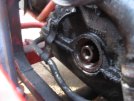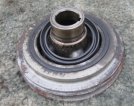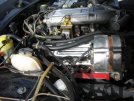:: Diary - January 2006 ::
:: Monday, January 2, 2006 ::
Remember in September while the car was getting the front rebuilt? And I ordered a front seal which it took the local
Ford garage about 5 weeks to find? And it cost me 17 quid too?
Well today I decided to fit it.
Step 1: raise bonnet to vertical (ie disconnect gas strut) and disconnect battery;
Step 2: Loosen alternator and remove fanbelt (I have a new one to fit anyway);
Step 3: remove vibration damper from front of crankshaft, first by removing its 4 mounting bolts and then using a proper
gear puller thing that fits (more or less) perfectly;
Step 4: (handbook version) undo centre bolt and remove crankshaft pulley. Sounds easy!
Step 4 (reality version) undo centre bolt and then discover that gear pully thing above doesn't fit, because the legs catch
on the water pump housing and timing plate and the chassis. Rethink required.
Step 4a: blooter pulley with piece of wood. It laughs in my face and stays put. As I knew it would.
Step 4b: go to Halford to buy small puller. The only one they have in stock would fit a bus or Chieftan tank but is
no good to me. Given that I want to get the car on the road, another method is required.
Step 4c: start to devise method of making pulley-puller. I find a piece of 3mm steel plate in the shed, which I hope is thick
enough, but still possible to drill through. I use the damper to mark two opposite holes that should line up with the threaded
holes in the pulley, and then drill them out using progressively larger drill bits. Precision engineering at its best.
Step 4d: Unscrew pulley centre bolt as far as it will go, then bolt the plate across the top. Now as I tighten the wee bolts,
it should pull the pulley off. In theory. Unfortunately the pulley is as tight as an Aberdonian's wallet, so the plate does bend
and the pulley stays put.
Step 4e: After rummaging about for ages for a thicker piece of steel, I give up. I wonder if it would work if I reinforced it with
something stronger? Another rummage and I come up with an old adjustable spanner whose handle seems to be just the right thickness.
Again put the two long bolts in, with the centre bolt wound in a little bit. Wedge the spanner diagonally between the two wee bolts,
across the top of the big one, and start tightening. I feel it crack free, and then I am able just to wind the bolts in and ease the
pulley off, helping it off the last bit with a crowbar. It's off! 3 hours this step has taken, including trip to Halfords,
rummaging time, engineering time etc.
 Here is this miracle of engineering, still attached to the front pulley, but without the reinforcing spanner. Good eh?
Here is this miracle of engineering, still attached to the front pulley, but without the reinforcing spanner. Good eh?
 This is the front of the engine, with the pulley removed. You can see the front of the crankshaft and, just inside the housing,
the red oil seal that has been leaking. You can also see several layers of grime that has stuck to the leaking oil, on the chassis
and the front of the engine. It is at this point that I notice a problem.
This is the front of the engine, with the pulley removed. You can see the front of the crankshaft and, just inside the housing,
the red oil seal that has been leaking. You can also see several layers of grime that has stuck to the leaking oil, on the chassis
and the front of the engine. It is at this point that I notice a problem.
 You see, the oil seal that Ford took weeks to obtain, and charged me 17 quid for, isn't the right one. This photo shows the new seal
on the pulley, and you can see that the fitting tolerance is a bit wider than Ford intended. It's obviously supposed to be tight
to keep the oil in and the muck out.
You see, the oil seal that Ford took weeks to obtain, and charged me 17 quid for, isn't the right one. This photo shows the new seal
on the pulley, and you can see that the fitting tolerance is a bit wider than Ford intended. It's obviously supposed to be tight
to keep the oil in and the muck out.
Trip to Ford dealer. The parts department is closed until Wednesday. A salesman makes the mistake of asking if he can help
so he gets the full tale of woe, the poor wee soul. They will see what they can do.
Meantime I can either leave the car dead, or put it back together as it was. Option B please!
Putting it all back only takes about half an hour. Taking it apart next time should also be easier because I know what I'm doing,
and have already engineered and tested the puller thingy.
I also notice that the new fanbelt is wider than the old one - about 12 mm rather than 9 mm. Careful comparison confirms that
the new one sits better in the pulleys, while the old one seems to be right down in the bottom of the vee.
A brief test drive confirms that it's all working, and not apparently leaking (at least not any worse than before!). It's
getting dark by this time though, so I can't clean all that oul and muck off the engine and chassis. A job for another day.
I can hear that exhaust manifold leak again though...
Also visited a local farm to ask if they have any barns or anything where I can store the car over the winter. They say they'll see
what they can do and call me.
:: Tuesday, January 3, 2006 ::
You might remember that I had the front of the car resprayed in September.
I haven't used the car a lot since, so have only washed it a couple of times. I can't remember if I've used car wash or just
warm water in the past.
Anyway today I decided I would wash the car properly, to take some insurance valuation photos. After the car had dried, I
noticed that the tops of both front wings are covered in tiny blisters - they look like the kind of thing you get from tree
sap, but are in the paint.
 Now they were definitely not there before washing - the car wasn't that dirty, and anyway I looked at the paint very closely
on Friday after I had the tyres fitted, to check for scratches.
Now they were definitely not there before washing - the car wasn't that dirty, and anyway I looked at the paint very closely
on Friday after I had the tyres fitted, to check for scratches.
I'll set out exactly how I washed the car:
1. Warm (not hot) water in a brand new plastic bucket - only used once before and that was to wash the Saab half an hour
before.
2. Two caps of Turtle Wax Extreme wash/wax (you can buy it in Halfords in limegreen bottles) added to the water.
3. A quick flash over with a pressure washer (I'd been cleaning the front of the engine first). The washer was set on a wide
spray soft setting, just to rinse the car and pre-soak the dirt - NOT a high-pressure jet.
4. Wash car with brand new (straight out of the packet) Meguiars sheepskin wash mitt - only used once before to wash Saab as
above!
5. Rinse car with pressure washer again on wide spray soft setting.
6. dry car off with Meguiars synthetic "wonder drying cloth" or whatever they call it - now this wasn't new, and had been
drying on a radiator since last time.
7. Final drying with a terry towel - although I did notice that this was tending to streak the paint as if it had polish on
it so I stopped using that after a few wipes.
The weather wasn't that cold (in fact I was sweating after washing two cars) and there was a sort of low watery sunshine.
The blisters are on a bit that I wiped with the terry cloth, and a bit that I didn't, so I don't think it's that. As far as
I can see, the Meguiars drying cloth is the only possible source of contaminant - but the rest of the paint on the car is ok.
I just don't understand. The garage who painted the car are closed until tomorrow but I don't know when I'll be able to take
the car in.
Advice on Pistonheads is that the bodywork hasn't dried out properly after rubbing down, so has been slightly damp when the
paint was applied.
:: Wednesday, January 4, 2006 ::
I was speaking to a mate today who has seen this paint-blistering thing before - it was indeed diagnosed as dampness in the
fibreglass, trapped under the paint. It was on his pal's Lotus. I realise that I know this Lotus-owner as well so he's
worth a chat, if necessary.
:: Thursday, January 5, 2006 ::
Went into the paintshop this morning. The estimator who dealt with my job took one glance at it, as I watched him carefully -
that first half-second reactions tell you what they REALLY think regardless of what they say afterwards... and he nearly
soiled himself. I could see a flash of recognition and a brief "Oh bugger" expression and then he said "Ah well, yes, I think
I'll have to get my assistant manager to look at this... but he's not in till this afternoon..." He said he would phone me
when he got back, so I could take the car in.
He phoned about 30 minutes later and said that the asst manager wanted the overall manager to see it and he's off till Monday.
- could I go back then? Well because I'm working I can't get in till next Saturday, and I said I didn't want to leave it
that long, this job had cost me a couple of thousand quid and it was really worrying me... so anyway the manager is coming
to look at the car at the house on Tuesday - if I can get him to come at lunchtime I can meet him here on my way back from a
meeting in Edinburgh. Their general attitude is apologetic and helpful, and they even thanked me for my patience... so I
don't think there's a problem, but if there is, I'll be ready.
Also, when I got home, the farm had phoned about the garage space - asking me to go and look at it tomorrow.
:: Friday, January 6, 2006 ::
Went to the farm to look at the garage today - and it seems pretty much ideal, except that there is a wee step at the door so
he is going to make up a wooden ramp. We agreed a reaqsonable price, he's going to confirm it all in the next couple of days,
and we'll agree an entry date after I get the paintwork problem looked at.
I was going to rent it only for the winter, but for all the difference, it will also be handy in the summer for some jobs and
also to keep the car secure while I am on holiday. So we're on an annual rent.
Obviously I'm not going to post the address or a picture of the farm on here!
:: Saturday, January 7, 2006 ::
 TVR Club meeting today. A lot of the cars are laid up for winter, and the roads are pretty manky and salty today, so it's not
exactly TVR driving weather. What the hell, I go back to work on Monday, this is my last chance for a run so off we go! I
set off a bit late so no time for removing the roof first.
TVR Club meeting today. A lot of the cars are laid up for winter, and the roads are pretty manky and salty today, so it's not
exactly TVR driving weather. What the hell, I go back to work on Monday, this is my last chance for a run so off we go! I
set off a bit late so no time for removing the roof first.
I notice on the way that the car handles much better on its new tyres on damp roads. Can't wait to see the difference in
the dry!
Most of the regulars are there and we have a good natter. Lots of events planned for this year, Willie has done well and I'll
have to try to share the road and organise at least one of the events later this year.
Noel (who knows a thing or two about these things) tells me that if I think I am going to successfully remove my leaking exhaust
manifold without at least one of the studs breaking off in the engine, then I would be better doing the lottery, because I would
have a better chance of winning. This kind of confirms my previous understanding. I decide that I am going to have one last try
at sealing the crack, before relenting to the risks of a new manifold.
Roof off for an enjoyable drive back. All the woes of the week are set aside - my wee car has captured me all over again!
:: Sunday, January 8, 2006 ::
Washed off all the road salt and muck from yesterday's run, including jet wash of chassis and outriggers.
I then decided to take some pictures to send off to the insurance company to change my policy to an "agreed value" rather
than book price. I already have the independent evaluation, I just need photos to send away.






These should do!
Also found that the exhaust bandage was loose again - waste of sodding time. Picked it all off with my fingers and then
wire brushed it down. I noticed that the crack is quite wide and is probably allowing too much escape pressure to blow
through the bandage. That was also probably making it difficult to braze. I use a hammer and blunt chisel to knock the
crack closed, and then re-braze along the crack and seal it completely. There is another much smaller crack underneath
that I can't reach from above, but when I start the car it sounds quieter already than it did yesterday!
I think I'll try to fill and bandage that small crack, it should be easier then trying to fill the whole lot.
:: Friday, January 13, 2006 ::
Got a letter from the insurance company today agreeing to the "agreed value". This is good news!
:: Saturday, January 14, 2006 ::
Right, went to the paintshop today.
He explained how they bake the panel before preparation and again before painting, to make sure it's dry - all the
precautions suggested by others I have spoken to.
They baked the car in the paint oven for about half an hour today, and the blisters have receded quite a lot, but
are still quite noticeable.
They said that some pattern parts aren't made to the same QA standards as factory panels, so air and dampness can be
trapped. They also pointed out that the reverse of the panel isn't gel-coated, and although they have painted it black,
it must still be porous, and that it must have absorbed water above the wheelarches.
I had been jetwashing the front of the engine just before washing the car, and the engine and exhausts were wet when
I started it up, just before these blisters appeared. I'm fairly sure the underside of the bonnet would have been wet as well.
It's possible that this moisture has been steamed up through air gaps in the panel and bubbled the paint.
Rather than get stuck in an argument between painter and panel supplier, we came to an agreement, he is going to
bake the bonnet, seal the reverse properly and repaint the surface. He says he's fairly sure that will sort it.
He is going on holiday for a week but will get it booked in after he returns.
I'm not exactly ecstatic about this but I just want it sorted without more hassle.
:: Sunday, January 22, 2006 ::
You know how sometimes you wake up early, while it's still dark, but you're suddenly wide awake? You might peek through
the curtains and see that it's dry and clear, and decide that it's a nice morning for a dawn blatt.
Get dressed - two fleecies, warm boots, hat and gloves. Car starts on the first turn of the key, let it idle quietly for
a wee bit (don't want to wake sleepy neighbours) and then pootle out of my road on idle, and then easy along the main
road till the engine warms. Once clear of sleepy suburbanites, stop to remove the roof, the better to enjoy the impending
dawn. Set off again just as the first flickers of pink light up the eastern horizon, the engine now warm enough for more
spirited hooning.
The roads are almost deserted, with only the occasional tintop with heater on full tandoori setting, to interrupt progress.
The smell of morning, the growing light of the sky, the chill of the air and the sound of the engine combine in a way that
is incomprehensible to those wrapped in air-conditioned heated-seated insulated isolation.
Finally the sun breaks the horizon over my right shoulder and the colours in the landscape become more vivid, like they do
after a rain storm. The new Bridgestones grip the road as we reach a particular series of open bends, the noise of the engine and exhaust
marking our progress as we jink left and right. Resisting the urge to turn around and repeat the most enjoyable sections
of road, we press on loudly on the open road, or more quietly through sleepy towns and villages.
After two hours, we return home, rumbling back into the street and parking, still before most of the neighbours are up.
It is days like these that make all the difficulties worthwhile. Never mind the repairs, the list of jobs still
to do, the frustrations... for days like these, to feel alive like this, nothing is too too much trouble.
I also drop in to see the man with the garage, and we agree on a takeover date in mid-February, by which time I hope that
the car will be repainted.
:: Monday, January 23, 2006 ::
Phoned the paintshop today.
I seem to have made a listening error - my man is on holiday till next week. I realise that he meant me to phone him
last week to book the car in next week. Never mind.
:: Sunday, January 29, 2006 ::
I decide to try to fill in the remaining crack in the exhaust manifold. I have bought a POR15 high-temperature steel-fix
kit, which apparently works up to 2000 degrees F. We shall see.
Unfortunately it takes me two hours and about 60 miles to turn the car round in the drive, and then another hour for
the exhaust to cool down enough to fill. Clean up the crack with a combination of wire brush and sandpaper, then
carefully mix and spread the filler over, then, according to the instructions, leave for two days to air dry.
So I do!
:: Monday, January 30, 2006 ::
Phoned the paintshop, taking the car in on Friday or Saturday. He says it should take about two weeks, which ties
in well with the likely availability of the rented garage.
 Here is this miracle of engineering, still attached to the front pulley, but without the reinforcing spanner. Good eh?
Here is this miracle of engineering, still attached to the front pulley, but without the reinforcing spanner. Good eh?
 This is the front of the engine, with the pulley removed. You can see the front of the crankshaft and, just inside the housing,
the red oil seal that has been leaking. You can also see several layers of grime that has stuck to the leaking oil, on the chassis
and the front of the engine. It is at this point that I notice a problem.
This is the front of the engine, with the pulley removed. You can see the front of the crankshaft and, just inside the housing,
the red oil seal that has been leaking. You can also see several layers of grime that has stuck to the leaking oil, on the chassis
and the front of the engine. It is at this point that I notice a problem.
 You see, the oil seal that Ford took weeks to obtain, and charged me 17 quid for, isn't the right one. This photo shows the new seal
on the pulley, and you can see that the fitting tolerance is a bit wider than Ford intended. It's obviously supposed to be tight
to keep the oil in and the muck out.
You see, the oil seal that Ford took weeks to obtain, and charged me 17 quid for, isn't the right one. This photo shows the new seal
on the pulley, and you can see that the fitting tolerance is a bit wider than Ford intended. It's obviously supposed to be tight
to keep the oil in and the muck out.







